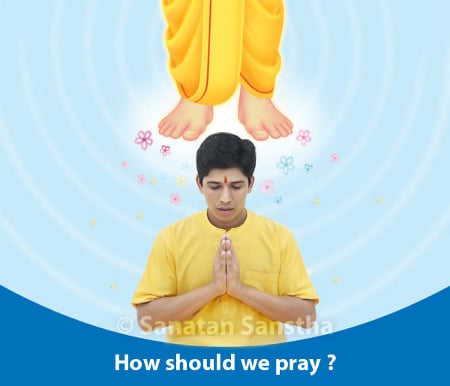
With intense humility unto God, pleading with yearning for a desired aspect is termed as a ‘prayer’. A prayer includes respect, love, pleading and faith. It does not have any restraint of place, time or purity-impurity. This article describes various stages in praying, progressing from prayer done with efforts to praying at regular intervals and finally praying with devotion and complete surrender unto the Holy feet of the Deity/Guru.
1. Prayer is a sadhana (Spiritual
practice) that is devoid of restraints !
A. No restraint of place
Just like chanting, the sadhana of prayers can be performed at any place such as in front of a Deity, in a house, in a courtyard, office, field, school, hotel, hospital, while travelling, sitting or lying in bed etc. In the initial stage, it is better to pray in front of a Deity to attain concentration. Later, praying can be done in other places too.
B. No restraint of time
‘Pray regularly, from morning till bed-time, not just during moments of sorrow but also during happy moments.’ (Monthly ‘Rushi Prasad’ November 2010)
(To maintain consistency in prayers, develop a habit of praying every 10 minutes. Methods such as setting an alarm on a mobile phone, requesting others to remind you etc. can be implemented. – Compiler)
C. No restraints of purity-impurity
Just like chanting, there are no restraints of purity, soyar-sutak (Impurity arising out of birth-death in family) etc. on praying.
2. Whom to pray ?
A. First stage
An ordinary individual should pray to his Kuladevata (Family Deity) or Deity of worship, while an individual who has a Guru should pray to his Guru.
B. Second stage
In addition to the prayers in the first stage, pray to the Deity associated with the respective task. For example, pray to the Deity of water before bathing and to Sri Annapurnadevi before a meal. This makes us realise the importance of the respective Deity and enhances our bhav (Spiritual emotion) of gratitude unto that Deity.
C. Third stage
In addition to the prayers mentioned under first and second stage, pray unto the instruments / tools that are of assistance in the respective task. For example, the user of a mobile phone should pray to the mobile phone and a housewife should pray to the utensils, stove etc. required for cooking. In this manner, an individual will learn to see the God Principle in all animate and inanimate objects. During the course of our sadhana, we have to move towards worship of one Deity from the worship of many Deities. Despite this, we have advised praying to various Deities and tools. The objective underlying such prayers is also explained at the respective places. When diehard faith that ‘There is no other easier path for deliverance except surrendering unto the Guru’s Holy feet’ develops for the Guru or Deity of worship, prayers mentioned under second and third stage need not be made.
3. How should we pray ?
A. Commonly used method
1. Keep the mind steady and calm during the prayer.
2. Join the hands in a namaskar-mudra (The palms joined and held at the level of the Anahat-chakra [The fourth centre in the spiritual energy flow system, located in the region of the heart in the subtle-body], but a little away from the body)
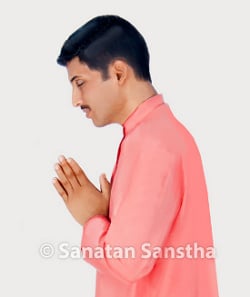
3. Visualise that the Deity or Guru is actually present in front of you or visualise the Holy feet of the Deity or Guru.
4. Concentrate on the Holy feet of the Deity or Guru for a few moments.
5. Pray in clear words. In the initial stages, to get used to praying, pray aloud. Later, it can be done mentally.
6. Concentrate on the words in the prayer and their meaning.
7. Instead of praying as if you are reading it out, try to communicate with God /Guru in a precise manner. For example, while praying that ‘let the obstacles in my sadhana be eliminated’, recall the obstacles that are repeatedly disturbing your sadhana and convey them to the Deity/ Guru in a precise manner.
8. Express gratitude unto the Deity/Guru for the fact that they themselves have got the prayer made through you.
B. Stages in praying
1. General stages
Once the importance of praying is understood, a numerical increase in it is expected initially. In the initial stages, praying takes place merely as a mechanical exercise of repeating words and is devoid of bhav. In the subsequent stages, a qualitative increase in praying is expected, that is, it is expected to be made with bhav. Given ahead are the general stages in praying.
A. First stage
In this stage, praying is done with efforts. It is desirable to pray with hands joined in a namaskar-mudra as it helps in early generation of bhav. (Later, when a sanskar [Subconscious impression] of praying develops in the mind, praying mentally without the namaskar-mudra also contains bhav.) In this stage, praying has a definite purport and specific words. Awareness that ‘I am praying’ is intense in this stage.
B. Second stage
Once we become well-versed in the practice of praying and when praying starts taking place at regular intervals, contemplation begins on it. Awareness develops that praying is a conversation with a Deity/Guru. Therefore, instead of taking place in a fixed pattern, praying takes place earnestly. It has bhav of pleading to the God/Guru.
C. Third stage
In this stage, there is a bhav that the Deity/Guru is actually standing in front and with an attitude of surrender we are bowing at His Holy feet and pleading. In this stage, not much effort is required to set words for a prayer; they come spontaneously.
D. Fourth stage
With passage of time, the sanskar of praying develops on the mind and we do not have to make efforts to pray. Along with chanting the Name, praying is spontaneous and with bhav. While praying we remember the form of the Deity/Guru, His Holy feet, gestures etc. The words for the prayer also originate from the heart. Depending on the situation, God suggests how to pray from within. This will be clear from an example mentioned ahead. Mr. Ghanashyam Gawade is a Sanatan seeker from Goa. Once he was given seva of blowing a conch during Arati (A ritual of waving a lit lamp) in the Ashram. He did not know how to blow a conch. He prayed to Srikrushṇa and later to SriGuru – ‘you only get this seva of blowing the conch done through my medium’. After this prayer he could blow the conch very well.
E. Fifth stage
In this stage, praying takes place with devotion and with complete surrender unto the Holy feet of the Deity/Guru. Very often there are no words in the prayer, just an emotion of gratitude. There is awareness that ‘I exist only for God/Guru and He is everything to me’. In the initial stages of praying gratitude needs to be expressed separately; however, in this stage we get a spiritual experience that both, the prayer and the gratitude are one.
2. It is possible to enhance spiritual emotions of gratitude and surrender by making prayers of progressively higher stages
‘A seeker in the initial stage of sadhana prays to God – ‘O God ! you remain with me’. A seeker in the intermediate stage of sadhana says, ‘O God ! Keep me at your Holy feet’. A seeker in the next stage says, ‘O God ! Let my thoughts be as per your expectations, let my actions be as per these thoughts and let the fruit of the actions be surrendered at your Holy feet’. A seeker in the next stage says, ‘O God ! you are making all this happen. Let everything happen according to your wish’. If we remain in communion with God according to these points and make prayers of progressively higher levels, then there is realisation that there is nothing which is really mine. God has control over everything in this animate and inanimate world. He Himself is making everything happen’. Thus, however hard we try to repay His debts, the efforts will be too trivial, and we realise that ‘we can never repay His debts’. Naturally then the bhav of gratitude and devout surrender will be enhanced. It is then that every activity of an individual reaches the Holy feet of God in the real sense.’ – Mr. Giridhar Bharghav Vaze (Kartik Shukla 9, Kaliyug Varsh 5112 [15th November 2010])
3. Examples of prayers of progressively higher levels and spiritual experiences
While sitting at a shop in the past, a ladyseeker would pray – ‘let there be no customers in my shop’, so that she could chant without any obstacles. Later, another lady-seeker told her that she should give up even that wish while praying. Thereafter, she started praying – ‘O God ! Let your wish prevail’. – H.H. Dr. Athavale (Poush Shukla 11, Kaliyug Varsh 5112 [16th January 2011])
A change in prayers resulting in a quicker change in the self
‘Earlier I would pray – ‘Let prembhav (Emotion of love) develop in me’. Now I pray – ‘O God ! Please generate prembhav in me so that I am able to love you’. This prayer changed the basic reason for bringing about a change in myself. Therefore, I realised that quick changes were taking place in me. I also realised that ‘once we decide to do something for God, He only gets it done.’ – Dr. (Ms.) Maya Patil, Sanatan Sanstha (July 2010)
4. The ultimate state of prayer
‘Forgetting that I am praying’ is the ultimate state of prayer.’ – Vaidyacharya (Dr.) Vasant Balaji Athavale, Chembur, Mumbai (Year 1980)

 Praying with purpose – Expectations vs Surrender
Praying with purpose – Expectations vs Surrender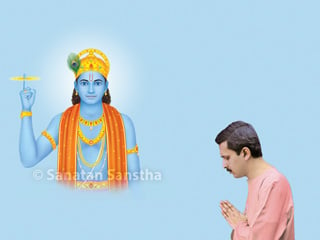 Some prayers which are useful to awaken bhav (Spiritual emotion) in day-to-day life
Some prayers which are useful to awaken bhav (Spiritual emotion) in day-to-day life Significance of prayer experienced by Non-Hindus
Significance of prayer experienced by Non-Hindus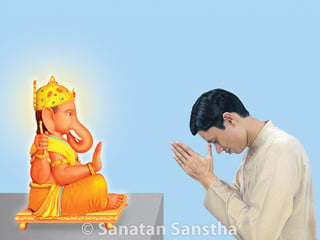 Prayers offered to Deities and associated with daily activities
Prayers offered to Deities and associated with daily activities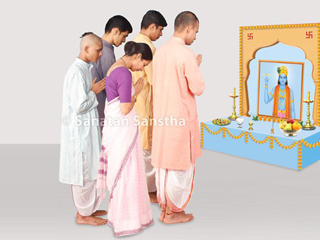 Importance and benefits of Prayer
Importance and benefits of Prayer Why should a prayer be done for expressing gratitude?
Why should a prayer be done for expressing gratitude?